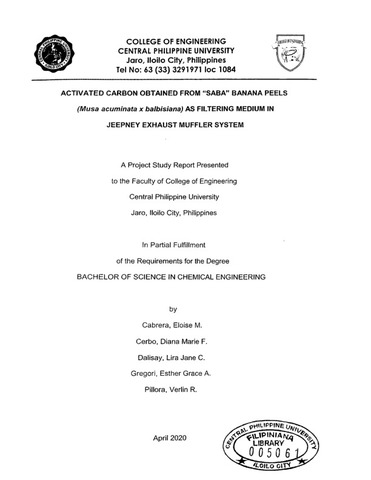Ipakita ang simpleng tala ng item
Activated carbon obtained from “saba” banana peels (musa acuminata x balbisiana) as filtering medium in jeepney exhaust muffler system
| dc.contributor.adviser | Pingul-Ong, Sheila Mae | |
| dc.contributor.author | Cabrera, Eloise M. | |
| dc.contributor.author | Cerbo, Diana Marie F. | |
| dc.contributor.author | Dalisay, Lira Jane C. | |
| dc.contributor.author | Gregori, Esther Grace A. | |
| dc.contributor.author | Pillora, Verlin R. | |
| dc.date.accessioned | 2023-08-31T06:33:03Z | |
| dc.date.available | 2023-08-31T06:33:03Z | |
| dc.date.issued | 2020-04 | |
| dc.identifier.citation | Cabrera, E. M., Cerbo, D. M. F., Dalisay, L. J. C., Gregori, E. G. A., & Pillora, V. R. (2020). Activated carbon obtained from “Saba” Banana peels (Musa acuminata x balbisiana) as filtering medium in jeepney exhaust muffler system [Unpublished special paper]. Central Philippine University. | en_US |
| dc.identifier.uri | https://hdl.handle.net/20.500.12852/2778 | |
| dc.description | Abstract only | en_US |
| dc.description.abstract | This study, entitled “Activated Carbon Obtained from “Saba” Banana Peels (Musa acum inata x balbisiana) as Filtering Medium in Jeepney Exhaust Muffler System”, aimed to design and construct an exhaust muffler system with activated carbon obtained from “Saba” banana peels as the filtering medium to adsorb the harmful emissions by diesel- fuelled jeepneys. This study shows a detailed experimental procedure of the production of activated carbon using pyrolysis process and the installation of the produced filter medium to the modified exhaust muffler system. Through a series of trials using smoke emission testing, results revealed the decrease of the number of hydrocarbons, carbon monoxide, carbon dioxide and oxygen giving a result of an average of 0% emissions. Results for the smoke density or light absorption coefficient (k) indicated that the smoke density decreased substantially in trials 2, 3, 4, and 5, where the modified muffler was attached to the tailpipe of the jeepney. The final average value of the light absorption coefficient (k) was 0.39, which indicates that the jeepney had passed the smoke emission test while the standard value of the light absorption coefficient was at 2.20. For the production of the filtering medium, different ratios of activated carbon and bentonite must also be used and tested with several trials to identify the optimal design for the filter medium. The screen size for the casing of the filter medium must also be smaller in order to prevent the activated carbon particles from sifting through. In order to produce a larger surface area that could increase the adsorption capacity of the activated carbon, it is recommended to mold the activated carbon into granules. | en_US |
| dc.format.extent | xii, 68 leaves | en_US |
| dc.language.iso | en | en_US |
| dc.subject.lcc | TP 155 .C33 2020 | en_US |
| dc.subject.lcsh | Bananas | en_US |
| dc.subject.lcsh | Filters and filtration | |
| dc.subject.lcsh | Automobiles--Motors--Mufflers | |
| dc.title | Activated carbon obtained from “saba” banana peels (musa acuminata x balbisiana) as filtering medium in jeepney exhaust muffler system | en_US |
| dc.type | Special paper | en_US |
| dcterms.accessRights | Not publicly accessible | en_US |
| dc.description.bibliographicalreferences | Includes bibliographical references | en_US |
| dc.contributor.chair | Jaspe, Christsam Joy S. | |
| dc.contributor.committeemember | Pescos, Dahlia H. | |
| dc.contributor.committeemember | Cangrejo, Bernie C. | |
| dc.contributor.department | College of Engineering | en_US |
| dc.description.degree | Bachelor of Science in Chemical Engineering | en_US |
| local.subject | Saba Banana peels | |
| local.subject | Musa acuminata x balbisiana | |
| local.subject.scientificname | Musa acuminata | en_US |


